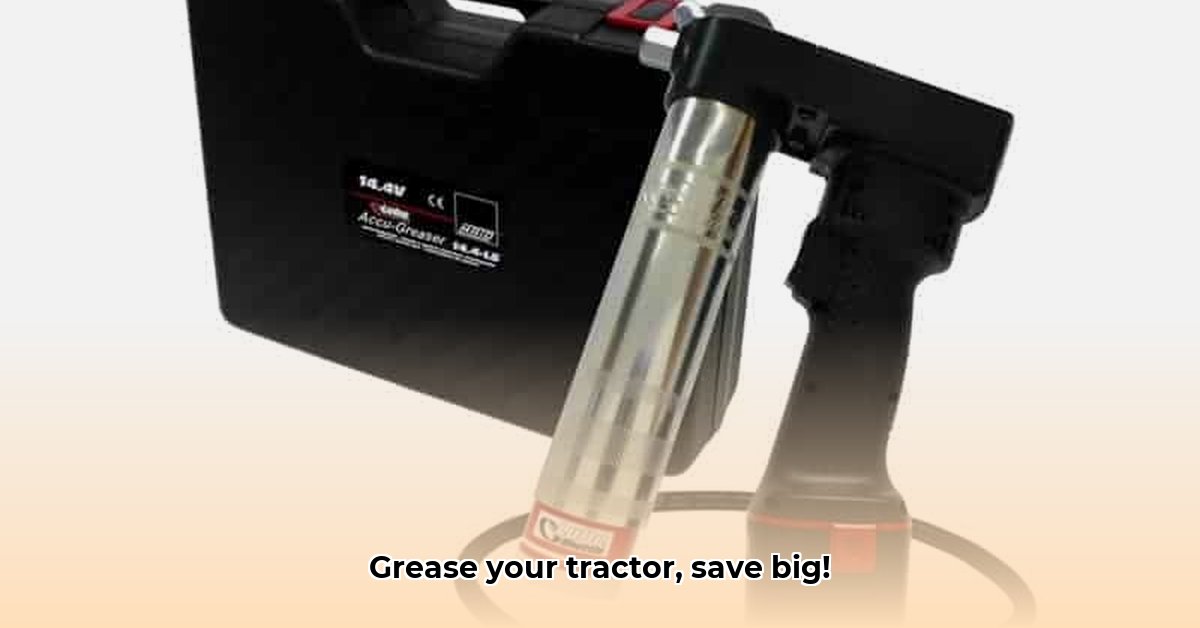
Keeping your farm equipment running smoothly isn't just about maximizing yields; it's about saving money and minimizing your environmental footprint. Proper lubrication is often overlooked, yet it's a cornerstone of sustainable agriculture. A well-maintained grease gun is your key to efficient, cost-effective, and environmentally responsible equipment maintenance. This guide equips you with the knowledge to choose, use, and maintain a grease gun effectively, extending the life of your valuable tractors and machinery. For more on maintaining your equipment, check out these helpful resources.
Choosing the Right Grease Gun: A Farmer's Guide
Selecting the ideal grease gun depends on your specific needs. Three primary types exist, each with distinct advantages and disadvantages:
1. Manual Grease Guns: These are the budget-friendly workhorses. Simple, reliable, and requiring no external power source, they are perfect for occasional greasing tasks on smaller equipment. However, they require more manual effort and are slower for larger jobs. Do you primarily grease smaller equipment infrequently? A manual grease gun might be your best bet.
2. Battery-Powered Grease Guns: Offering a balance between power and convenience, these cordless grease guns are ideal for regular use on medium-sized equipment. They eliminate the need for cumbersome cords but require charging and will eventually need battery replacement. If you grease your equipment frequently, a battery-powered unit might be efficient choice.
3. Pneumatic Grease Guns: These are powerhouses designed for large-scale operations and heavy-duty applications. They provide rapid, high-volume greasing, but require a separate air compressor, adding to the initial investment and complexity. Are you dealing with extensive equipment or large greasing tasks? This model might be the perfect solution despite the initial investments.
Here's a comparison table summarizing the key differences:
| Grease Gun Type | Pros | Cons | Ideal Use Cases |
|---|---|---|---|
| Manual | Affordable, simple, reliable, low maintenance | Requires more physical effort, slower greasing | Occasional use, smaller equipment |
| Battery-Powered | Convenient, cordless, moderate power | Needs charging, may require battery replacement | Regular use, medium-sized equipment |
| Pneumatic | Powerful, fast greasing, high-volume output | Requires air compressor, more complex, higher cost | Large equipment, frequent, high-volume greasing |
Choosing wisely saves both time and money. Consider your equipment, frequency of use, and budget to make the best decision. Remember that incorrect selection might lead to wasted time, effort, and even damage to your equipment.
Mastering Greasing Techniques: A Step-by-Step Approach
Proper greasing is a skill that directly impacts your equipment's longevity. Follow these steps for optimal results:
Step 1: Preparation is Key: Thoroughly clean the area around the zerk fitting (the grease nipple) using a wire brush or rag to remove dirt and debris. This prevents contamination.
Step 2: Secure the Connection: Firmly attach the grease gun nozzle to the zerk fitting. Ensure a leak-proof seal.
Step 3: Controlled Application: Slowly and steadily apply the grease, observing for fresh lubricant to emerge from the fitting. Avoid over-greasing, which can be as detrimental as under-greasing.
Step 4: Excess Removal: Wipe away any excess grease with a clean rag to prevent attracting contaminants.
Step 5: Consult the Manual: Always refer to your equipment's manual for specific lubrication points, recommended grease type, and quantities to ensure optimal performance and proper maintenance. Neglecting this crucial step might significantly impact your machine’s life.
Grease Selection and Storage: Maintaining Quality
Choosing the right grease for varying temperatures and applications is crucial. Tractor Supply offers various greases formulated for different needs. Remember to store grease in a cool, dry place away from direct sunlight and moisture to maintain its quality and prevent waste. Isn't it surprising to find out that improper grease storage can reduce its effectiveness?
Grease Gun Maintenance: Extending Its Lifespan
Regular maintenance keeps your grease gun functioning optimally. After each use, clean the nozzle and other grease-contacting parts. For pneumatic guns, check for air leaks. Address any sluggishness or malfunctions promptly; a well-maintained grease gun helps avoid costly repairs and delays in the future.
Sustainability and Environmental Responsibility
Proper lubrication is an essential component of sustainable farming practices. By extending equipment life and reducing the need for replacements, you minimize waste and lessen your environmental impact. Explore eco-friendly, biodegradable grease options to further enhance your environmental stewardship. Small changes can make a big difference in maintaining your equipment and protecting the environment.
Key Takeaways: Maximize Efficiency, Minimize Costs
- The choice of grease gun significantly impacts efficiency and equipment longevity.
- Consider frequency of use, needed grease pressure, and specific applications when selecting a grease gun.
- Proper lubrication minimizes equipment replacement, resulting in reduced waste and environmentally conscious farming.
- Regular maintenance of your grease gun ensures efficient operation and extends its lifespan.
By following this guide, you can confidently maintain your farm equipment effectively, saving money, reducing environmental impact, and ensuring years of dependable service from your valuable machinery.